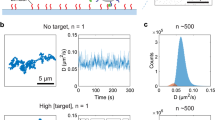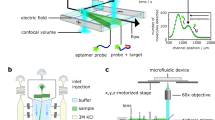Abstract
Membrane proteins are central to many biological processes, and the interactions between transmembrane protein receptors and their ligands are of fundamental importance in medical research. However, measuring and characterizing these interactions is challenging. Here we report that sensors based on arrays of resonating microcantilevers can measure such interactions under physiological conditions. A protein receptor—the FhuA receptor of Escherichia coli—is crystallized in liposomes, and the proteoliposomes then immobilized on the chemically activated gold-coated surface of the sensor by ink-jet spotting in a humid environment, thus keeping the receptors functional. Quantitative mass-binding measurements of the bacterial virus T5 at subpicomolar concentrations are performed. These experiments demonstrate the potential of resonating microcantilevers for the specific, label-free and time-resolved detection of membrane protein–ligand interactions in a micro-array format.
This is a preview of subscription content, access via your institution
Access options
Subscribe to this journal
Receive 12 print issues and online access
$259.00 per year
only $21.58 per issue
Buy this article
- Purchase on Springer Link
- Instant access to full article PDF
Prices may be subject to local taxes which are calculated during checkout





Similar content being viewed by others
References
Howard, A. D. et al. Orphan G-protein-coupled receptors and natural ligand discovery. Trends Pharmacol. Sci. 22, 132–140 (2001).
Cooper, M. Advances in membrane receptor screening and analysis. J. Mol. Recogn. 17, 286–315 (2004).
Hall, D. A., Ptacek, J. & Snyder, M. Protein microarray technology. Mech. Ageing Dev. 128, 161–167 (2007).
Hansen, K. M. & Thundat, T. Microcantilever biosensors. Methods 37, 57–64 (2005).
Lavrik, N. V., Sepaniak, M. J. & Datskos, P. G. Cantilever transducers as a platform for chemical and biological sensors. Rev. Sci. Instrum. 75, 2229–2253 (2004).
Fritz, J. et al. Translating biomolecular recognition into nanomechanics. Science 288, 316–318 (2000).
Backmann, N. et al. A label-free immunosensor array using single-chain antibody fragments. Proc. Natl Acad. Sci. USA 102, 14587–14592 (2005).
McKendry, R. et al. Multiple label-free biodetection and quantitative DNA-binding assays on a nanomechanical cantilever array. Proc. Natl Acad. Sci. USA 99, 9783–9788 (2002).
Zhang, J. et al. Rapid and label-free nanomechanical detection of biomarker transcripts in human RNA. Nature Nanotech. 1, 214–220 (2006).
Mukhopadhyay, R. et al. Cantilever sensor for nanomechanical detection of specific protein conformations. Nano Lett. 5, 2385–2388 (2005).
Mertens, J. et al. Label-free detection of DNA hybridization based on hydration-induced tension in nucleic acid films. Nature Nanotech. 3, 301–307 (2008).
Braun, T. et al. Conformational change of bacteriorhodopsin quantitatively monitored by microcantilever sensors. Biophys. J. 90, 2970–2977 (2006).
Bálint, Z. et al. Direct observation of protein motion during the photochemical reaction cycle of bacteriorhodopsin. Langmuir 23, 7225–7228 (2007).
Gupta, A., Akin, D. & Bashir, R. Single virus particle mass detection using microresonators with nanoscale thickness. Appl. Phys. Lett. 84, 1976–1978 (2004).
Gupta, R., Akin, D. & Bashir, R. Detection of bacterial cells and antibodies using surface micromachined thin silicon cantilever resonators. J. Vac. Sci. Technol. B 22, 2785–2791 (2004).
Gfeller, K. Y., Nugaeva, N. & Hegner, M. Rapid biosensor for detection of antibiotic-selective growth of Escherichia coli. Appl. Environ. Microbiol. 71, 2626–2631 (2005).
Nugaeva, N. et al. An antibody-sensitized microfabricated cantilever for the growth detection of Aspergillus niger spores. Microsc. Microanal. 13, 13–17 (2007).
Braun, T. et al. Micromechanical mass sensors for biomolecular detection in a physiological environment. Phys. Rev. E 72, 031907 (2005).
Burg, T. P. et al. Weighing of biomolecules, single cells and single nanoparticles in fluid. Nature 446, 1066–1069 (2007).
Niesters, H. G. M. Molecular and diagnostic clinical virology in real time. Clin. Microbiol. Infect. 10, 5–11 (2004).
Poynard, T., Yuen, M. F., Ratziu, V. & Lai, C. L. Viral hepatitis C. Lancet 362, 2095–2100 (2003).
Braun, V. & Braun, M. Iron transport and signaling in Escherichia coli. FEBS Lett. 529, 78–85 (2002).
Böhm, J. et al. FhuA-mediated phage genome transfer into liposomes: a cryo-electron tomography study. Curr. Biol. 11, 1168–1175 (2001).
Locher, K. P. et al. Transmembrane signaling across the ligand-gated FhuA receptor: crystal structures of free and ferrichrome-bound states reveal allosteric changes. Cell 95, 771–778 (1998).
Freifelder, D. Molecular weights of coliphages and coliphage DNA. IV. Molecular weights of DNA from bacteriophages T4, T5 and T7 and the general problem of determination of M. J. Mol. Biol. 54, 567–577 (1970).
Boulanger, P. et al. Purification and structural and functional characterization of FhuA, a transporter of the Escherichia coli outer membrane. Biochemistry 35, 14216–14224 (1996).
Jap, B. et al. 2D crystallization: from art to science. Ultramicroscopy 46, 45–84 (1992).
Lambert, O. et al. An 8-Å projected structure of FhuA, A. ‘ligand-gated’ channel of the Escherichia coli outer membrane. J. Struct. Biol. 126, 145–155 (1999).
Lambert, O., Letellier, L., Gelbart, W. M. & Rigaud, J. L. DNA delivery by phage as a strategy for encapsulating toroidal condensates of arbitrary size into liposomes. Proc. Natl Acad. Sci. USA 97, 7248–7253 (2000).
Plancon, L. et al. Characterization of a high-affinity complex between the bacterial outer membrane protein FhuA and the phage T5 protein pb5. J. Mol. Biol. 318, 557–569 (2002).
Wagner, P., Hegner, M., Kernen, F., Zaugg, F. & Semenza, G. Covalent immobilization of native biomolecules onto Au(111) via N-hydroxysuccinimide ester functionalized self-assembled monolayers for scanning probe microscopy. Biophys. J. 70, 2052–2066 (1996).
Kenna, J. G., Major, G. N. & Williams, R. S. Methods for reducing non-specific antibody binding in enzyme-linked immunosorbent assays. J. Immunol. Methods 85, 409–419 (1985).
Müller, D. J., Amrein, M. & Engel, A. Adsorption of biological molecules to a solid support for scanning probe microscopy. J. Struct. Biol. 119, 172–188 (1997).
Ghatkesar, M. K. et al. Resonating modes of vibrating microcantilevers in liquid. Appl. Phys. Lett. 92, 3106–3109 (2008).
Dorrestijn, M. et al. Chladni figures revisited based on nanomechanics. Phys. Rev. Lett. 98, 026102 (2007).
Feucht, A., Heinzelmann, G. & Heller, K. J. Irreversible binding of bacteriophage-T5 to its FhuA receptor protein is associated with covalent cross-linking of 3 copies of tail protein-pb4. FEBS Lett. 255, 435–440 (1989).
Braun, V. & Endriss, F. Energy-coupled outer membrane transport proteins and regulatory proteins. Biometals 20, 219–231 (2007).
Bieri, C., Ernst, O. P., Heyse, S., Hofmann, K. P. & Vogel, H. Micropatterned immobilization of a G protein-coupled receptor and direct detection of G protein activation. Nature Biotechnol. 17, 1105–1108 (1999).
Heyse, S., Vogel, H., Sanger, M. & Sigrist, H. Covalent attachment of functionalized lipid bilayers to planar waveguides for measuring protein binding to biomimetic membranes. Protein Sci. 4, 2532–2544 (1995).
Ghatkesar, M. K. et al. Higher modes of vibration increase mass sensitivity in nanomechanical microcantilevers. Nanotechnology 18, 445502 (2007).
Dohn, S., Sandberg, S., Svendsen, W. & Boisen, A. Enhanced functionality of cantilever based mass sensor using higher modes. Appl. Phys. Lett. 86, 233501 (2005).
Tamayo, J., Humphris, A. D. & Malloy, A. M. Chemical sensors and biosensors in liquid environment based on microcantilevers with amplified quality factor. Ultramicroscopy 86, 167–173 (2001).
Feng, X. L., He, R., Yang, P. & Roukes, M. L. Very high frequency silicon nanowire electromechanical resonators. Nano Lett. 7, 1953–1959 (2007).
Despont, M., Drechsler, U., Yu, R., Pogge, H. B. & Vettiger, P. Wafer-scale microdevice transfer/interconnect: Its application in an AFM-based data-storage system. J. Microelectromech. Sci. 13, 895–901 (2004).
Bietsch, A., Zhang, J., Hegner, M., Lang, H. P. & Gerber, C. Rapid functionalization of cantilever array sensors by inkjet printing. Nanotechnology 15, 873–880 (2004).
Hendrickson, H. E. & McCorquodale, D. J. Genetic and physiological studies of bacteriophage T5 I. An expanded genetic map of T5. J. Virol. 7, 612–618 (1971).
Grange, W., Husale, S., Guntherodt, H. J. & Hegner, M. Optical tweezers system measuring the change in light momentum flux. Rev. Sci. Instrum. 73, 2308–2316 (2002).
Tamayo, J., Ramos, D., Mertens, J. & Calleja, M. Appl. Phys. Lett. 89, 224104 (2006).
Braun, T. et al. Digital processing of multi-mode nano-mechanical cantilever data. J. Phys. Conf. Series 61, 341–345 (2007).
Braun, T. et al. Processing of kinetic microarray signals. Sens. Act. B 128, 75–82 (2007).
Acknowledgements
We thank A. Engel for the use of facilities for protein reconstitution at the Biozentrum, University of Basel, and M. Chami for fruitful discussions. We thank D. Mathys, M. Düggelin and M. Dürrenberger for their help with the SEM analysis. Financial and general support is acknowledged from Swiss National Science Foundation (NCCR Nanoscale Science), the Commission for Technology and Innovation (CTI) (TOPNANO21), the European Learning and Teaching Mobility Regio Network, the G.H. Endress Foundation, the Novartis Foundation and the Science Foundation Ireland CSET programme. M.K.G. thanks the Swiss National Science Foundation and the Novartis Foundation for a research fellowship.
Author information
Authors and Affiliations
Contributions
T.B. and M.H. conceived and designed the experiments; T.B. and M.K.G. performed the experiments; T.B., M.K.G., W.G. and M.H. analysed the data; P.B. and L.L. contributed expertise in membrane proteins and phages; A.B. and T.B. were responsible for the ink-jet spotting of the membrane proteins; T.B., N.B., W.G., H.P.L. and M.H. co-wrote the paper. All authors discussed the results and commented on the manuscript.
Corresponding author
Supplementary information
Supplementary Information
Supplementary Information (PDF 797 kb)
Rights and permissions
About this article
Cite this article
Braun, T., Ghatkesar, M., Backmann, N. et al. Quantitative time-resolved measurement of membrane protein–ligand interactions using microcantilever array sensors. Nature Nanotech 4, 179–185 (2009). https://doi.org/10.1038/nnano.2008.398
Received:
Accepted:
Published:
Issue Date:
DOI: https://doi.org/10.1038/nnano.2008.398
This article is cited by
-
Discrete element modeling of cantilever beams subjected to geometric nonlinearity and particle–structure interaction
Computational Particle Mechanics (2021)
-
Modified cantilever arrays improve sensitivity and reproducibility of nanomechanical sensing in living cells
Communications Biology (2018)
-
Atomic force microscopy-based characterization and design of biointerfaces
Nature Reviews Materials (2017)
-
An optimised silicon piezoresistive microcantilever sensor for surface stress studies
Microsystem Technologies (2016)



